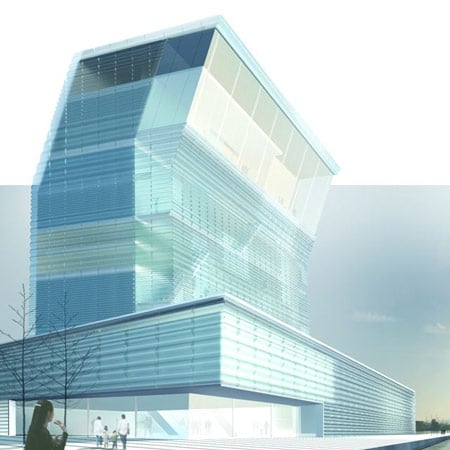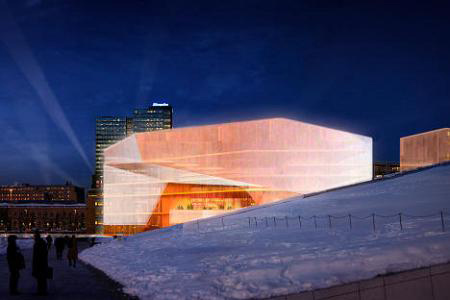
Munch museum and Deichman library competition winners
Spanish practice Herreros Arquitectos and Norwegian architects Lund Hagem Arkitekter with Atelier Oslo have won two separate competitions to design a museum and library respectively in Oslo, Norway.

The buildings are both to be located next to the Oslo Opera House, completed by Norwegian architects Snøhetta early last year (see our previous story).
Top image: Herreros Arquitectos' design for the Munch museum, called Lambda. Above: Diagonale library design by Lund Hagem Arkitekter with Atelier Oslo.
More information on the competition website.
Here's some more information from the competition organisers:
--
Spanish and Norwegian winners of the architect competitions
Spanish and Norwegian architect offices are the winners of two separate architect competitions in Bjørvika, Oslo. Herreros Arquitectos came out on top in the Munch competition with their entry “Lambda”, while Lund Hagem Arkitekter AS and Atelier Oslo AS were ranked as number one in the Deichman competition with their environmentally-friendly concept entitled ”Diagonale.”
“I would like to thank the architects for their excellent contributions and HAV Eiendom for a well-organised architect competition,” says Oslo’s Chief Commissioner Erling Lae. “I am also delighted that so many citizens have visited the exhibition. We will now ensure that the winning proposals evolve into new premises for the Munch/ Stenersen Museum and the Oslo Main Library, and that we develop Bjørvika to become Oslo’s new cultural district.”
The panels of judges have ranked three and four entries respectively in the two separate competitions, and both juries have been unanimous in their decisions. The Munch/Stenersen ranking is as follows:
Munch
1. ”Lambda” by Herreros Arquitectos (Spain)
2. ”Yin-Yang” by REX Architecture (USA)
2(?). “Girls on the bridge” by Christ & Gantenbein (Switzerland) and Lie Øyen Arkitekter (Norway )
“The positioning and the sophisticated style of the building has resulted in “Lamda” standing out as a beautiful and modern museum. It is both elegant and iconic in all it’s simplicity,” says jury foreman Helle Søholt.
The Deichman ranking is as follows:
Deichman
1.”Diagonale” by Lund Hagem Arkitekter and Atelier Oslo (Norway)
2. “Meeting place/diversity/openness/exploration” by Schmidt Hammer Lassen (Denmark)
4(?). “Intermezzo” by Snøhetta (Norway )
4. “Between” by David Chipperfield Architects (Great Britain) and Norske Div. A Arkitekter (Norway )
The Deichman-jury has also given two special mentions. The 2 projects are;
"Body & Mind" by kister scheithauger gross architekten und stadtplaner GmbH in coorperation withanOther Architect (Germany)
"Open Minds" by a-lab (Norway)
“Besides being the highest-scoring candidate with respect to the environment, the urbane ’Diagonale’ provides a very good solution for the library. The concept has enormous potential that can result in a highly innovative library,” says jury foreman Berit Kjøll.
Since 12th March, when the exhibition of competition entries was opened to the public, over 16,000 people have visited the hall of art behind the National Museum in order to see for themselves the illustrations and models of the 39 entries.
“There has been a tremendous amount of public interest, and we hope and believe that the winning entries will be well received. We are very pleased that two such broadly-composed panels of judges should have come up with two clear winners,” says Eva Hagen, Managing Director of HAV Eiendom.
The final decision regarding which buildings will be chosen for the two cultural institutions rests with the Oslo City Parliament.
HAV Eiendom is a wholly-owned company of the Port of Oslo Authority, and is the City of Oslo’s development company for urban planning of the Bjørvika area. Company activities comprise the planning, renting and managing of property, as well as the buying and selling of real estate in Bjørvika. It owns most of the property in the area – approx. 15.6 hectares. The development of HAV Eiendom’s sites in Bjørvika will extend over several years. Progress will be co-ordinated with the agreed removal of the Port of Oslo Authority’s harbour-related activities from the area.
LAMBDA by Herreros Arquitectos
The focus of this urban project is centered on the necessary relationship between the desired areas and the existing city in the unique context configured by the fjord, coastlines and geographical features that condition it. We are not proposing a site with isolated phenomena.
We propose a dynamic, fruitful conversation with the surroundings, a proposal that selects the appropriate uses, scales and densities that in turn articulate the spatial forms of occupation, the dimensions and treatment of the public space and its sustained growth towards the future.
The first guideline of our proposal is a sequence of connected public spaces that are strongly characterized and sufficiently large to formulate a dialogue between the scales of the architectonic features of the area, thus integrating them into a general, readable system.
Secondly, we will detail the built programs to corroborate with the suggested locations of the Master Plan: we locate the museum in the B-11 lot and then the housing programme in lots B-4 and B-5, maintaining a steadfast suggestion to stagger the heights of the buildings towards the sea.
For the residential area we have chosen an organization of blocks which are parallel to the city and slightly displaced with each other in order to ensure continuity of views and visual richness of urban perspectives which are rounded off in a square resolving the transition on through to the Museum.
The Museum is developed with slight verticality, choosing a posture which shows a double attention towards the fjord and towards the city, standing respectfully to the east of the opera house, thus extending and completing its silhouette.With these decisions we confidently intend to work on the visibility and perception of the set of buildings, from the city, to the fjord, to the high areas from which the history of Oslo will be understood in one coherent image.
The ground plan takes on great importance in our project and we imagine the set of the public space + ground floors of the building as a plan with great dynamism and leisure, commercial and productive activity, designed in detail and intensely “naturalized” and accessible, which attracts a flow of users which is not limited to residents and tourists.
This will be the base for the new central nature that we want to stamp on Bjørvika and which explains our efforts in rounding off the system of public spaces generated with a unique action in the islands and the beach which open onto the fjord, and providing these privileged places with landscaped and programmed attractions so as to ensure that they are used intensively by the public.
It is worth saying now in advance that we leave the small island on the south of the Museum free, which may become a complementary enclave to the museum, and the Snelda island for which we propose a sporting and hedonistic program related to contact with the sun, the wind and water understood as urban water park or a natural park. In the peninsula adjacent to the opera, we maintain the plan of locating a beach, a tourist port and bus stop for the buses which will serve the museum, the port and the water park.
DIAGONALE by Lund Hagem Arkitekter and Atelier Oslo
The Diagonale solution for the new Deichman Library proposes:
To divide the site into three buildings. By doing this, we give each building a human scale and integrate the project into the city.
To place the Library on the site towards Operaallmenningen. Library visitors are offered the best views towards the city, the fjord and the surrounding green hills of Oslo; and the shortest connection to public transport.
To make the Library visible to the public. The top of the library cantilevers out to announce its presence to the visitors arriving from down town Oslo and the Central Station. At the same time the view to the opera is secured by a large cut in the volume.
To create entrances to the east, west, and south. Big cuts in the facade mark the entrances on three sides of the building, inviting the public coming from all parts of the city. The same cuts give views into the different environments of the library.
To create a spectacular interior. The core of the new Deichman library is based on light and space and continuous diagonal views established between the library interior and the surrounding streets/square. Through atriums and openings in the different floors the library is united with the city outside.
To communicate with the city. The façade diffuses the sunlight, giving a calm feeling to the interior. At night, the building will glow and change appearance as a reflection of all the different activities and events inside the library.
What happens with the winners and the ranked consepts in the Munch/Stenersen- competition and the Deichman-competition?
Friday 27. th of March 2009 the winners and ranked projects of both competionons were announsed publically. The jurys verdicts are now written into two juryreports. Both reports will be public after the Easter-holiday.
The jurys verdicts will be sent to HAV Eiendom AS as the employer of the competitions. The board of HAV Eiendom will handle the jurys decitions and will then send all the ranked projects (3 in the Munch-competition and 4 in the Deichman-competition) to the Port of Oslo. HAV Eiendom is owned by 100 % by the Port of Oslo. When the board of Port of Oslo also has handled the ranked proposals, all of this will be forwared to the Municipality of Oslo. This will happen April the 20.th.
The town counsil of the Municipality of Oslo makes the final decition of what projects that is going to realized.